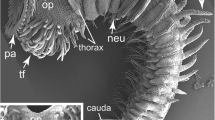Abstract
Cuticular differentiations on the body surface and the pharyngeal armature of adult Tubiluchus corallicola van der Land were examined with the scanning electron microscope. The morphology of abdominal tumuli, flosculi and tubuli, and of pectinate teeth and fimbrillae on the pharynx is described, and an attempt is made to interpret their functional properties. Taking into account the structural details, relative size, and topographic arrangement in relevance to interaction with the interstitial environment, we assume that tumuli are protective, flosculi chemoreceptive, and tubuli adhesive, and that the pharyngeal armature is a scraping mechanism for feeding on epigrowth on sand grains.
Similar content being viewed by others
Literature cited
Anderson, T. F.: Techniques for the preservation of three-dimensional structure in preparing specimens for the electron microscope. Trans. N. Y. Acad. Sci. 13, 130–134 (1951).
Boaden, P. J. S.: Grazing in the interstitial habitat: a review. In: Grazing in terrestrial and marine environments, pp 299–303. Ed. by D. J. Crisp. Oxford: Blackwell Scientific Publications 1964.
Coull, B. C.: Shallow water meiobenthos of the Bermuda Platform. Oecologia 4, 325–357 (1970).
Kirstener, E. and J. van der Land: Some notes on Tubiluchus corallicola (Priapulida) from Barbados, West Indies. Mar. Biol. 7, 230–238 (1970).
Land, J. van der: A new aschelminth, probably related to the Priapulida. Zoöl. Meded., Leiden 42, 237–250 (1968).
— Systematics, zoogeography, and ecology of the Priapulida. Zool. Verh., Leiden 112, 1–118 (1970).
Lang, K.: Über die Entwicklung von Priapulus caudatus Lam. K. fysiogr. Sällsk. Lund Förh. 9, 80–87 (1939).
Moritz, K. und V. Storch: Elektronenmikroskopische Untersuchung eines Mechanorezeptors von Evertebraten (Priapuliden, Oligochaeten). Z. Zellforsch. mikrosk. Anat. 117, 226–234 (1971).
Remane, A.: Die Besiedlung des Sandbodens im Meer und die Bedeutung der Lebensformtypen für die Ökologie. Zool. Anz. (Suppl.) 16, 327–359 (1952).
Swedmark, B.: The interstitial fauna of marine sand. Biol. Rev. 39, 1–42 (1964).
Wieser, W.: Die Beziehung zwischen Mundhöhlengestalt, Ernährungsweise und Vorkommen bei freilebenden marinen Nematoden. Ark. Zool. 4, 439–484 (1953).
Author information
Authors and Affiliations
Additional information
Communicated by J. Bunt, Miami
Supported in part by NSF Grant GB-7952 to the first author.
Rights and permissions
About this article
Cite this article
Kirsteuer, E., Rützler, K. Additional notes on Tubiluchus corallicola (Priapulida), based on scanning electron microscope observations. Mar. Biol. 20, 78–87 (1973). https://doi.org/10.1007/BF00387678
Accepted:
Issue Date:
DOI: https://doi.org/10.1007/BF00387678




